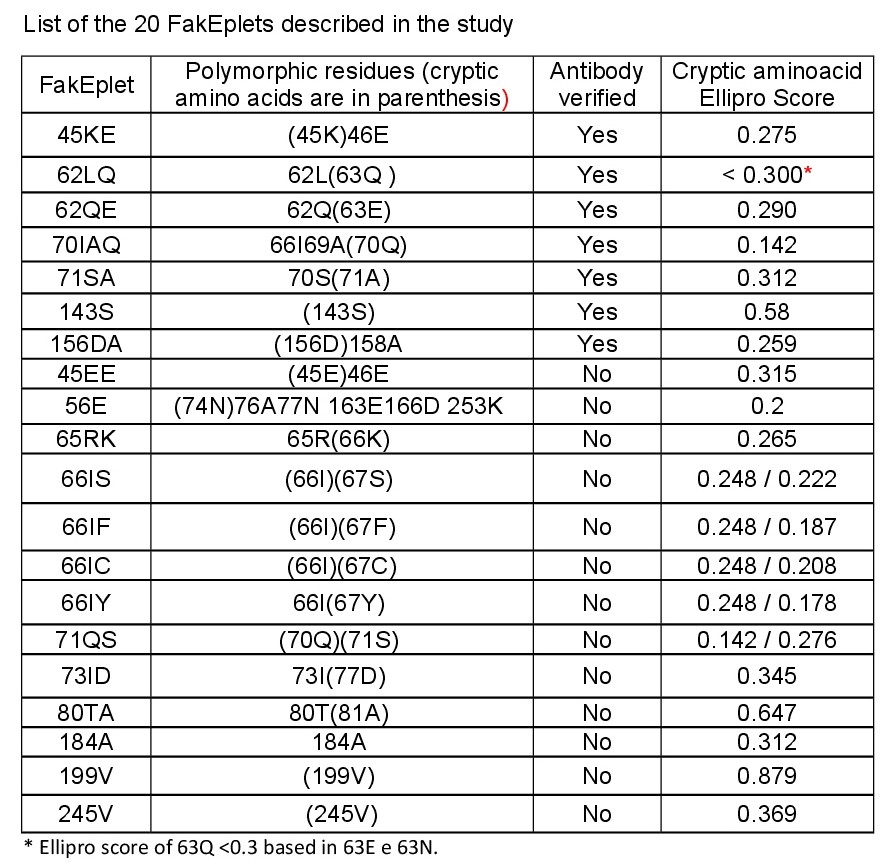Report of 20 HLAMatchmaker Eplets Present on Denatured Class I HLA Molecules
1Immunogenetics Institute, AFIP, Sao Paulo, SP, Brazil, 2Immunogenetics Laboratory, Universidade Federal do Paraná, Curitiba, PR, Brazil
Meeting: 2019 American Transplant Congress
Abstract number: C5
Keywords: Alloantigens, HLA antibodies, Immunogenicity, MHC class I
Session Information
Session Name: Poster Session C: Histocompatibility and Immunogenetics
Session Type: Poster Session
Date: Monday, June 3, 2019
Session Time: 6:00pm-7:00pm
 Presentation Time: 6:00pm-7:00pm
Presentation Time: 6:00pm-7:00pm
Location: Hall C & D
*Purpose: The purpose of this report is to describe 20 class I HLA eplets, herein called FakEplets, present on denatured HLA molecules.
*Methods: The study included 18 sera that presented a total of 20 suspicious positive reactions in the Luminex Single Antigen (L-SA) assay (One Lambda). These sera were from different patients on kidney transplant waitlist. In order to test whether the reactions were really false-positive, the sera were tested with the same L-SA assay but with beads with HLA molecules denatured by acid treatment. The efficacy of the acid treatment was checked with the w6/32 monoclonal antibody. The epitopic analysis was performed with the HLAMatchmaker (HLAMM) software of the International HLA Epitope Registry (Epregistry 2.0, www.epregistry.com.br); the eplets were analyzed in the Cn3D macromolecular structure viewer program for determination of the potential cryptic positions which were further analyzed in terms of Ellipro Score (Duquesnoy & Marrari, 2017).
*Results: As shown in the table, among the 20 identified FakEplets, there were 7 (35%) considered as antibody verified in the Epregistry, 7 (35%) corresponded to 66/67 and/or 70/71 cryptic positions, and 8 (40%) presented Ellipro score > 0,300 in the cryptic residues. These results show that at least 20, out of the 223 class I HLA eplets described in the Epregistry 2.0, are present on denatured HLA antigens.
*Conclusions: We conclude that the “antibody verified” status and/or a high (> 0.3) Ellipro score are not sufficient to classify an eplet as a biological “true” eplet. Therefore, the continuous refinement of the HLAMM algorithm, with the inclusion of information based on experimental data, would be crucial to improve its value for the application in epitope-based HLA matching in clinical transplantation.
To cite this abstract in AMA style:
Marco Rde, Lima AC, Pereira NF, Gerbase-DeLima M. Report of 20 HLAMatchmaker Eplets Present on Denatured Class I HLA Molecules [abstract]. Am J Transplant. 2019; 19 (suppl 3). https://atcmeetingabstracts.com/abstract/report-of-20-hlamatchmaker-eplets-present-on-denatured-class-i-hla-molecules/. Accessed December 26, 2025.« Back to 2019 American Transplant Congress

